#THE EXISTENCE OF BENDING WAS EXPLAINED BY PEOPLE OBSERVING NATURE AND IMITATING IT. OR BEING TAUGHT SPECIFIC ANIMALS
Text
i know im not breaking new ground for saying legend of korra is disappointing but so much of the series is genuinely off putting to me. the setting, the tone, how the narrative tortures korra it feels like
which is a shame because I love korra as a character (even if her writing isn't The best at times). but there are so many aspects of the show I don't like. fuck there's so many characters in the show I dont even like either
#says a lot how even when im not rewatching atla in its entirety i enjoy watching clips of it from time to time or analysis videos on whats#good about the show...#i have not touched TLOK since i watched the show finale when it aired#i cant stand mako. i dont even really like bolin much either#i feel like the biggest aspect of TLOK that holds it back is the fact that it wanted to be more 'mature'#ignoring the fact that the og series -was- quite mature. as in it knew when to take itself seriously! TLOK has a superficial idea of-#-maturity it feels like. like 'ohhh ohhhhh look we showed an airbender do killing isnt that cool!!" what the fuck EVER#I DONT CARE. i dont care when it feels like a slog to get thru the show and when u add things that mess w/ the allure -#- of the og show. I dont WANT to know how the first avatar came to be or why the spirit world exists#THE MYSTIQUE WAS WHAT MADE IT SO APPEALING#THE EXISTENCE OF BENDING WAS EXPLAINED BY PEOPLE OBSERVING NATURE AND IMITATING IT. OR BEING TAUGHT SPECIFIC ANIMALS#NOT BECAUSE OOHH LOOK THE LION TURTLES GAVE IT TO PPL TO TRAVERSE THE SPIRIT WILDS.... lame!! LAME!!#im angrier about this than i need to be lmao#the whole lion turtle thing just sounds like the show runners felt insecure about the finale of the OG series lol
8 notes
·
View notes
Text
Gojo and Mahito
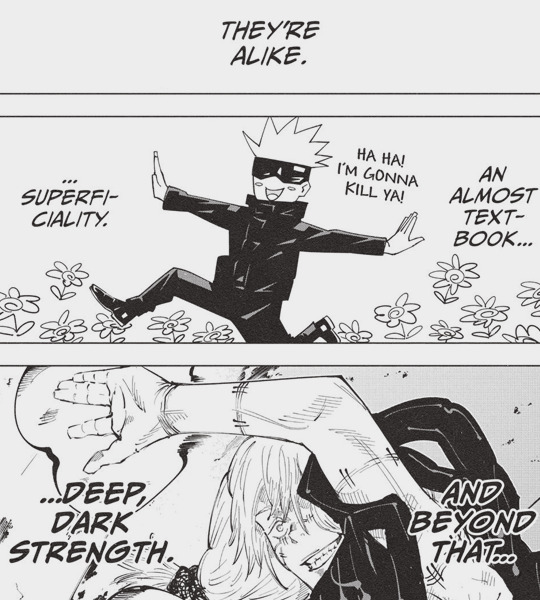
Nanami and Gojo share several parallels as pointed out by Nanami in Chapter 22 of Jujutsu Kaisen. A connection between the two of them that’s developed to the point where we see Mahito steal a technique from Gojo (domain expansion activation for only a few microseconds) in the latest chapter. More on the parallels of Gojo and Mahito, because for both of them there’s more than meets the eye.
1. Children with Too Much Power
Mahito parallels Gojo, but more specifically I believe he has the most in common with teenage Gojo we see in Hidden inventory. Especially on two key points. Both of them had immense strength that they hadn’t quite figured out yet.

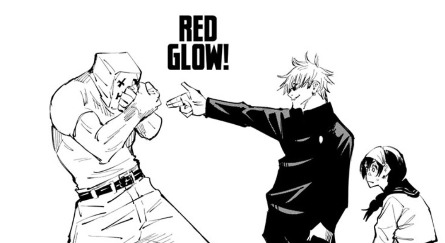

Teenage Gojo, who was still figuring out the infinity and could not yet quite make the universe bend at the snap of his finger tips. In his introductory arc when Mahito was fighting Nanami, he was like a child figuring out how to use his body for the first time.
Everything he does in that arc is out of a childish sense of curiosity. He gets to close to Junpei, to observe what will happen from prolonged interaction with a human. He toys around a long time with fighting Nanami because he’s still figuring out how his curse technique works.
Unlike the other curses who seem to already exist knowing what they are, or have existed for years already long enough to figure themselves out, Mahito is actively learning about himself when he fights Nanami.

Just like Gojo, being pushed to the brink of death by an incredibly powerful enemy, only seems to make Mahito bounce back stronger. Mahito and Gojo parallel each other in their comparison to Nanami. Simply put, Nanami is the most mature character in the series, he’s the role model for a normal, decent adult.
While Gojo will drag children to battlefields, or take big bets with their lives, Nanami acts much more responsibility, with respect to the fact that Yuji is a child whose emotional well being he’s nurturing.

Nanami is introduced to us as the opposite of Gojo, someone mature while Gojo is immature. He even says that he doesn’t respect him in the least bit. Gojo’s powerful, but he’s not grown up. Nanami even explains this quite logically, people don’t grow up by fighting bad guys, or getting stronger. People grow up by accumulating experiences.


Gojo and Mahito are all powerful in ways that Nanami will never be, while at the same time they act like children. Especially teenage Gojo, but even adult Gojo doesn’t really like to get along well with other people, and decides everything based on his own emtoions and perspective. In other words both Gojo and Mahito have a tendency to be egocentric.
Egocentric.
thinking only of oneself, without regard for the feelings or desires of others; self-centered.
2. The World Through Their Eyes
Mahito and Gojo are characters who appear childish and frivolous on the surface, but if you plunge their depths they have a deeper understanding of themselves and their desires than most ofther characters in the series. They might not get other people, but that’s not their priority either. In classic Jungian symbolism, shallow water belies greater depths.
Gojo and Mahito are both extremely well thought characters, capable of immense amounts of self reflection. (Probably too much self reflection in Gojo’s case, he just loves looking at himself in the mirror a little too much how vain.) It not only shows in how much of themselves they have figured out but also their jujutsu. I think it’s safe to say that there is some resemblance between the infinity, and Mahito’s idle transifguration. Their Jujutsu makes them both privvy to the world that no one else can see. It’s unknown what Gojo can see with the six eyes exactly, but considering the limitless.

You can infer that he’s capable of seeing much greater sensory perception than the normal person. Mahito doesn’t have the six eyes, but because his jujutsu is about altering the form of the soul, he has the unique ability to see the shape of the soul inside of the body.

Mahito can see through people’s bodies, and see down to their souls. However, his perceptiveness has caused him to give up on the idea that people have any individuality at all, that they have “hearts” you know like, thoughts and feelings and stuff. Which is why all humans are pretty much interchangable to him. Mahito can’t see life separate as him from having any particular value.

Both of their cursed techniques create distance between themselves and others. Though in opposite ways. Gojo’s cursed technique is based around the idea that nothing can reach him, because it will always slow down in the infinite space between them. Mahito is able to completely change the shape of whatever he wants with one touch.
However, at the same time this resembles how they both interact with other people. Mahito sees people as nothing more than toys to play with and experiment in developing his jujutsu technique on. He even is literally pictured in an official color illustration as destroying Junpei, Nobara, and Nanami as torn up dolls. They were just toys that he got bored with and threw away.

Gojo can sometimes even share this tendency, not to mercilessly kill and slaughter of course not, but to be so far away from other people, and too busy perceiving the infinity that he can’t get caught up in ordinary lives. Remember, Mahito, Jogo and Hanami’s plan was to shake up Gojo with the sheer amount of people he would have to save in Shibuya, and it just... didn’t work.
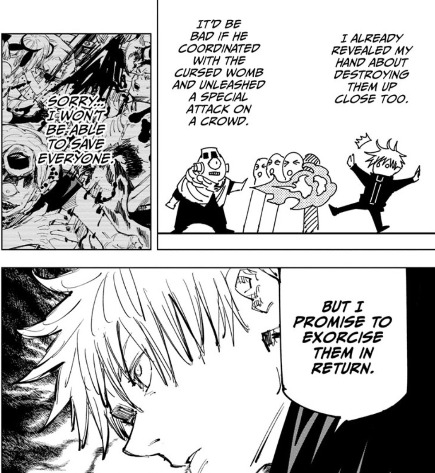
Gojo just isn’t that shaken up by the people he can’t save. He’s not Geto. He’s not Yuji. Of course he cares enough to try and minimize the damage, he could have just used unlimited domain to end the situation at the cost of everybody gathered, but he made a decision to try to balance between everybody’s lives, protecting his own, and exorcising the curses.
Mahito and Gojo are both extremely distant from other people, but because of that they have a unique understanding of themlseves. Mahito’s domain expansion is called “Self Embodiment of Perfection.” When Gojo figures out reverse Jutsushiki he quotes the budha when he reached enlightenment.
They are extremely isolated characters who have others plumbed the depths of themselves. Gojo’s goal is to be the best version of himself he can be, to push himself into being the strongest. Their individual will is so strong they want to impose it on the world around them. Gojo wants to reset the jujutsu world, Mahito wants a world of curses.

They both encourage the other people around them to also think deeper about themselves, and how to evaluate themselves. Gojo tells Mahito to stop repressing himself for the sake of others. To try to be stronger individually instead of more of a team player. Instead of judging those around you, look inwardly.

Mahito is furious that Yuji doesn’t evaluate himself, doesn’t think deeply about his own motivations. That’s what he criticizes Yuji for constantly, he doesn’t think for himself, he runs blindly into fights. Mahito calls their fight a clash of truth. Yuji has to know his own self, and know his belifs and know why his beliefs are better than Mahito’s if he wants to face him.
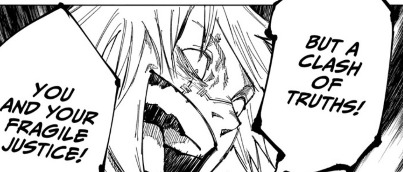
Mahito and Gojo are both always looking inside of themselves, and that’s why their depths go much further than their seemingly shallow surface. If I were to make one last comparison between the two of them, I would say that the reason Mahito imitates Gojo is because his end goal is to become enlightened. What Mahito wants, is to be true to his nature, the truest embodiment of a curse in the series. He wants to reach an enlightenment like Gojo has where he has himself, his role in the world, completely and totally figured out. Where he embodies his own idealized sense of perfection.
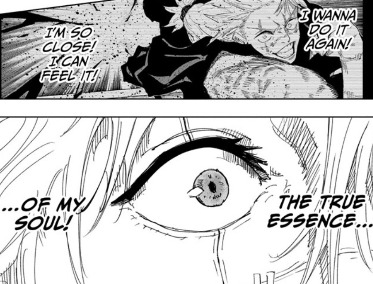
Which is why he imitates Gojo, the strongest. Though his is the opposite path, like a reflection of a mirror. If Gojo uses his power to be the model, the embodiment of a jujutsu sorcerer who exorcises curses to save human lives, then Mahito chooses to be the embodiment of a curse that plagues humans.
Mahito and Gojo both see through things, they can see what everybody else can’t, however they differ in how they use those perceptions. Gojo tethers himself to responsibility to other people, because he finds meaning in doing that, he thinks there’s a point in protecting and nurturing the weak because eventually he’ll be able to find strong comrades. Mahito however, believes in the opposite of camraderie. He can see through other people, so he acts like they’re not even there. Gojo is a character who while his tendency is to try do everything on his own, is currently waiting rescue from the strong comrades he focused so hard into training. While Mahito will most likely end up alone.
#gojo satoru#satoru gojo#gojou satoru#satoru gojou#mahito#jjk meta#jujutsu kaisen meta#jujutsu kaisen analysis#jujutsu kaisen#jujutsu analysis#jujutsu meta
632 notes
·
View notes
Text
AKB Analysis 1 - How Toons Exist & "Plausible Impossible"
Took a while to make a proper introduction post to this place.
Anyway, this blog’s dedicated to my “Toontown Crossover” AU, where I’ll come in bringing ideas and interpretations on how Toons and Anime would function on modern times, while shedding more light on ambiguous questions or implications on works portraying animated fictional characters as physical entities living alongside real people.
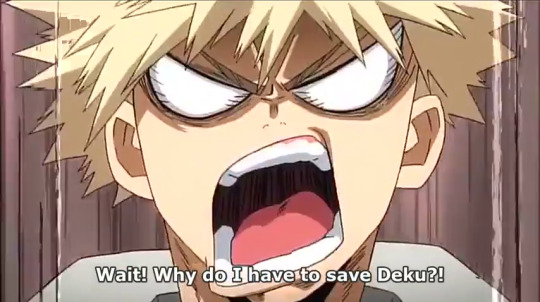
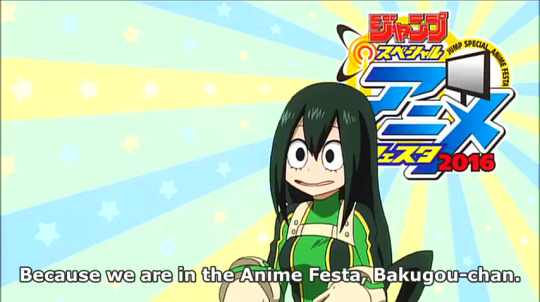
Let’s start with some fundamental questions:
1 - "Where Toons (and Anime-characters A.K.A "Chara") come from": In my AU, Toons (and Anime) actually start out as regular illustrations that have similar kind of life to toys from Toy Story: coming to life only when not being seen except for the original author and their partners, and living a real life via being the constructs, elements and ideas that all together create the world and the story they live and experience, though all are basically walking cuts of paper that speak only through speech bubbles or text that emerge from their backs.
One day however, after animation was born around 1920s, it gave away for the characters to jump out of the paper due a phenomenon called "Plausible Impossible".
vimeo
Plausible Impossible stands for a term meaning that something which should be impossible becomes acceptable and rational either through having some factual basis, or being forced to ac under common logic and rules enough to become acceptable.
Right down to how the animation made them seem "alive", the toons became pretty much "real" for the animators and soon real people alike. Though it's only very good animators that can produce toons that can move well in real life. Modern ways of making Toons be alive is more ambiguous in this regard.
2 - "Warping reality as long as it is funnier/cool otherwise": This actually pertains back to my previous point about "Plausible Impossible", as it is very tied to this kind of a phenomenon. Basically, as long as a Toon seems to establish the rules or their own character vividly enough in relation to how things work in their cartoons' "sense of reality", the easier it is for them to break the logic or play around it to amusing, or even cool results.
When compared to American Toons and how they're well known for mostly playing under "Rule of Funny" mostly, Anime-characters seem to go for "Rule of Cool", though not being also beyond using Rule of Funny which has their own unique flavor. When in the Rule of Cool though, this has them use amazing types of superpowers or even be said to have, or reach omnipotence according to certain works, and other kinds of boundary-breaking feats.
Thus kind of thing got worrisome to me due how this would have been very dangerous for people in the real world to deal with, since if an Anime character might be known for being able to break buildings or even an entire planet to pieces, it would be impossible to make a believable world for Anime to work.
To prevent this, my AU has it that given "traits" and "powers" of a Toon or Anime is relative to the knowledge they have about it, and how feasible it is to do in the Real World in any realistic means incase they go ever there.
To explain in detail, they would have to see the sources of the things they are affiliated or related to in real life, through observation, media or literature, etc. This helps them to raise their mileage of "Plausible Impossible", through establishing known facts or things about their powers or traits and thus enabling them to have more believability to them. This is mitigated by concept of "scripts" by the directors or authors themselves, who build basically these rules or setups that characters are able to subvert easily due it all being made for them. (Hence they can do whatever actually they do in the movies - even to the point of not having to establish any rules in more shallow or off-the-factory fiction.)
For example, In WHRR, Roger Rabbit putting cuffs on Eddie has him exploit the audiences general knowledge about how the cuffs can't be taken out, more exemplified by how Eddie himself is struggling with it- and Roger himself, initially. Let's just say that in general Roger Rabbit and Toons have an average common sense and knowledge relative a regular American person, knowing what the ever hell the handcuffs are.
Going further, Avatar: The Last Airbender's characters would read about the way their respective natural elements work before putting their imagination on use to bend them. Later on they would discover doing this more consistently via incorporating various styles of martial arts to them, creating what is their own way of governing these elements.
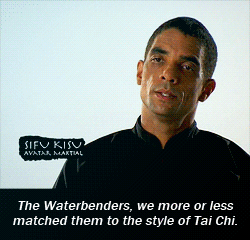

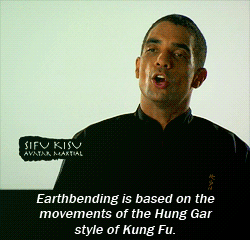


On topic on how characters are able to use these powers outside of "acting", they have to train it from the ground-up themselves - though the author might have transplanted it as part of their character or psyche, but they still would have to go to Real World to see how it works in detail.
For example, if someone is able to control electicity, upon gaining an "animated body" from animation cels or other things, they still can't conjure much the said powers they are able to do on their own according to the creator/artist's interpretation, which means he/she would have to know how it is depicted in real life, and if wanting to go even further, research about it and be able to reproduce such facts in their own way under their use. Thus it’s their knowledge and versatility with such abilities that allows them to exhibit such feats - which is very important for Benders, Alchemists and Espers, etc.
Mikoto Misaka of Certain Scientific Railgun is a great example of this, with the versatility feats reached via ability electromagnetism control being not limited to weapons out of iron sand or firing metal objects at three times the speed of sound - but is capable of flight by splitting the hydrogen from water to create booster wings, or decode electric information inside computers, which allows her to hack them with relative ease.

Using these powers or traits however more easier to do in the animated dimensions (ToonTown, KyaraTokai) due not being heavily confined to logic like the Real World and it's laws of nature is.
However, certain powers or phenomena are still monitored, especially if they are in form of exaggerations. For example, as there's so many hapless and cosmically unlucky male protagonists from various works, the world would basically fall apart due trying to keep on putting them through beyond ridiculous amounts of misfortune (Everything affects something). So for them, the unluckiness becomes drastically mellowed and monitored to only regular occassions along with moments of fortune coming to them like regular people, though they might still receive tad higher type of misfortune, but not necessarily life-ruining kind.
Sometimes there's also curveballs upon happening (Getting Megaton Punched upon walking to a girl changing mind sometimes land you on a thug that has been wanted by the law, netting you some good pocket change. Basically, box of chocolates.)
In Real World, using the powers or exhibiting the exaggerated traits that break reality will be take away some of the character's own "essence", which if overly used without proper recharging, render them immobile like a walking animation cel that got separated from others. The way how things work in Real World and it's laws of nature can help Toons/Anime mitigate such damage though as long as they abide to it now and then.
3 - "Why Toons/Anime might take animated acting anyway"
Aside from being able to "live their own story", as fit from their author/artist(s) ala Toy Story, there's also the fact that the "essence" in all living things in Real World are vital and desirable for them. These are referred as "material" things. They basically contain essence of life, which is what makes the Toons/Anime be able to sustain themselves and stay "alive". They also get to experience whatever the thing the artist or writer interpreted for them is really like in real life.
For example the material (real) food is more tastier than imitating "drawn food". Can create interesting reactions around characters, but in general, they really take in the "essence" that come from trying these things in the real flesh.
Take Remy having his famous synesthetic tasting scene from Ratatouille when eating "real" food:
youtube
And apply that to Toons, which might feel it enough to produce possibly strong or interesting visual reactions, as it's how they interprete real life things due being more like idol-like imitations, constructs of them all.
Roger Rabbit with alcohol, for example, has this reaction due being 1940s Toon, coming apparently apparently an entire summing about what happens when people get drunk.
youtube
When we people consume too much alcohol, or even one tiny flask of a STRONG alcoholic beverage, we tend to become loose cannons and talk loudly without even knowing we are raising our voices (aka, Roger's ear drum shattering steam whistle.)
Followed by uncontrollably inane movements depending on how drunk the beverage leaves us (aka, Roger's mindless shaking and swaying once he's airborne as a whistle.)
And then comes the classic part of any drunk fit or tantrum: Various things within the household are left in pieces. Depending on whether or not the mood swing is leaning more towards your vile, crazy side, nearby objects are bound to take the fall (aka, all the glass items blowing up.)
Some famous people though learn to tolerate this over time however, and might even send off “techniques” to let others pick up the same tolerance:
youtube

Basically eating a real-life sandwich is gonna be better than "drawn sandwich" because drawn sandwich is most likely lines put together to look like a sandwich, but the real-life one is that which houses actual taste and nutrition, all coming from the gifts of living Earth itself.
(”Drawn”)

(Real)

While below, isn’t.
For this reason, most Toons and Anime act their stories out or other things in animated adaptations or original works in order to get money, goods and services which lets them even further unlock their own potential while also living a life like that of other living things in real world, experiencing all kinds of things in their distinct ways.
That got long - until next time -

9 notes
·
View notes
Text
Doc vs. Challenger
Character, “one of the attributes or features that make up and distinguish an individual,” (Merriam-Webster). If we were devoid of our traits, personality, and other attributes; we would fail to be distinct. We would be bland individuals who lacked depth. Therefore, when authors pen their work, they strive to imitate human nature by weaving some of man’s more common characteristics into their stories. They try to create “realistic” characters, which their readers can relate to and sympathize with because that is in part, what keeps their readers engaged. Doc Savage, from Kenneth Robeson’s novel, Doc Savage: The Land of Terror is written in such a way as to suggest that Robeson sought to engross his readers by creating a protagonist, which possessed the qualities of a “superhero.” This is due to the fact that it would appear as though Doc is good at everything—he is knowledgeable in a number of different fields such as chemistry and biology, can hypnotize people with his eyes, fly a plane, hold his breath underwater for extended periods of time, etc. Furthermore, he has the body of a Greek god, is physically strong, and an excellent fighter. He is also extremely agile, has keen senses, is modest, and polite. He travels the world with a group of friends and doesn’t seem to have any true flaws or weaknesses. Therefore, readers are bound to find some way to relate to him as there are many different aspects to be found within his character to which one can draw a connection. However, his “overabundance” of positive traits and interests transforms Doc Savage into an otherworldly, bland character because he is the “perfect, static character.” Nothing appears as though it presents a true challenge to him. In sharp contrast, the “ape-like” Professor Challenger from Sir Arthur Conan Doyle’s The Lost World is an imperfect a being as they come. He proves to be a more complex and dynamic character than Doc, as he changes subtly throughout the course of the novel. He is also ill-tempered, poor mannered, and proficient in only a narrow area. Furthermore, it takes him the full length of the novel to make any friends, while Doc beganThe Land of Terror within the company of a small group of friends. However, Challenger began the novel as a married man, while Doc never demonstrated any interest in women.
Professor Challenger and Doc Savage look nothing like one another. On his first meeting with the Professor, Mr. Malone provided a description of Challenger, which made him appear as though he was larger than life. Part of this characterization stems from the fact that Malone described his head as being “enormous,” (Doyle 23). Another portion stems from Challenger’s possession of both an imposing countenance and a black beard, which Malone associated “with an Assyrian bull,” (Doyle 23). The remainder of Challenger’s overwhelming presence originates from his “blue-gray eyes,” which were later described as “masterful,” broad shoulders, a barrel chest, and “two enormous hands covered with long black hair,” (Doyle 23-24). Furthermore, Professor Challenger’s resemblance to the king of the ape men whom he and his fellow travelers discovered while exploring Maple White Land accentuated the reader’s earlier impressions of both his massive and bestial appearance. Although it was said of the king “that his coloring was red instead of black,” (Doyle 115), little else differentiated the pair except for the disparity cast by the shape of their heads “above the eyebrows, where the sloping forehead and low, curved skull of the ape-men were in sharp contrast to the broad brow and magnificent cranium of the European,” (Doyle 115). Doc Savage, on the other hand, may be described as a being with the figure and strength of a Greek god. He had a distinctive and powerful face which was marked by “a remarkably high forehead,” a “muscular and strong mouth,” and “lean, corded cheeks,” (Robeson 73). He also had bronze-colored skin, which was mirrored by the color of his hair, although, it was a “shade darker than the bronze skin. It lay straight and smooth,” (Robeson 73). Doc was also known for being rather tall, with a frame “lost” in “perfect symmetry,” (Robeson 73). However, “the most striking thing about him was his eyes. They were like pools of fine flake gold glistening in the sun,” (Robeson 74). Doc was also extremely muscular, to the point where he was described as an “Atlas,” (Robeson 89). His muscles “were not knotty, but more like bundled piano wire lacquered a deep bronze color,” (Robeson 89). I feel as though each character’s appearance, which was strikingly different from the other, was utilized by their respective author in order to hint at the nature of the body’s owner. Professor Challenger’s appearance, which was likened to an ape, suggested that his character still needed to “evolve.” In other words, there was still room for growth, change, development, and overall refinement. Doc Savage’s, on the other hand, suggested that he had already reached the height of humanity and had ascended into godhood or at least something akin to the divine. In other words, he was the “ideal man,” someone who was polite, powerful both mentally and physically, and blessed with many different talents and skills.
In creating a “superhuman” character within his work, Robeson developed a being who was proficient in many different areas. Sir Arthur Conan Doyle’s Professor Challenger, on the other hand, possessed a more “human” skillset in the sense that he was proficient in only a narrow area. Professor Challenger being a “famous zoologist,” (Doyle 18), was wholly a man of science. Prior to the trip he would make with Mr. Malone and company, he had already “made a journey to South America… to verify some conclusions of Wallace and Bates,” (Doyle 29). He spent a great deal of time both contesting “lesser” individuals within his field or verifying the facts made by other keen observers and scientists. His breadth of knowledge in the field of zoology became particularly evident whenever he contested Professor Summerlee about some matter or tried to classify the prehistoric life forms, which the travelers found within the Maple White Land. Doc Savage, on the other hand, appeared to be a man who was good at everything and who knew everything. His vast skillset and knowledge were explained as a mixture of training beneath the most talented men in a particular field, (such as Jerome Coffern in the field of chemistry), and a series of mental and physical exercises, which he performed for a few hours out of every day. Doc’s vast stores of knowledge had allowed him to contribute “new discoveries to more than surgery and chemistry. Electricity, archaeology, geology, and other lines have received the benefit of his marvelous brain,” (Robeson 73). Furthermore, he was able to perform intricate math problems entirely in his head, impersonate other people with ease, track both humans and animal life effectively, fly an airplane, and hypnotize the unwary with his gaze. Such was the case in the beginning of the novel, when he used his amazing power upon one of Kar’s men, so that he could discover what had happened to his late mentor, Jerome Coffern. “It was amazing, the things Doc could do with his eyes. He had studied with the great masters of hypnotism, just as he had studied with famous surgeons… By the time Doc asked his next question, he had exerted such a hypnotic influence… that the fellow replied with the truth,” (Robeson 80). Naturally, his ability proved useful because it allowed him to learn of the existence of the dissolving agent, the “Smoke of Eternity.” Doc’s newfound knowledge was beneficial because he would need to avoid the substance upon his return trip home from Oliver Wording Bittman’s apartment. He accomplished this by jumping over the edge of the Central Park West bridge as it was engulfed by the “Smoke of Eternity” his assailant had unleashed. He hid underwater, which he found a simple enough feat because “his lungs were tremendous. He could readily stay under water twice as long as a South Sea pearl diver, and such men have been known to remain under several minutes,” (Robeson 89).
Doc’s training in conjunction with his strength, also lent him a certain degree of agility and martial prowess, which Professor Challenger does not possess. Jerome Coffern said that Doc’s “strength and agility are incredible… for Doc Savage it is child’s play to twist horseshoes” and “bend silver half-dollars between thumb and forefinger,” (Robeson 73). The full extent of his strength is demonstrated towards the center of the novel when he is trapped within a passage of the Jolly Roger by Kar’s men and the ceiling begins to descend upon him. “The dropping roof would have crushed the life from a body a whit less like springy steel than Doc’s. The mass of the monster timbers must have weighed a full ton… Doc caught the massive weight… He broke the deadly force somewhat. But the shock bore him to hands and knees,” (Robeson 107). The extent of Doc’s agility becomes evident when he distracted the tyrannosaurus rex of Thunder Island as his friends escaped. “Only the power and agility of his mighty bronze body saved him, for once he had to dodge between the very legs of the monster, evading by a remarkable spring snapping, foul, fetid teeth that were nearly as long as a man’s arm,” (Robeson 122). Furthermore, he is a good marksman and very capable in both hand-to-hand and armed combat. Professor Challenger, on the other hand, is not described as being either particularly agile or strong. Perhaps his “barrel” chest in some way limited him, it is difficult to say. However, it can be said that like Doc, he has the capacity to shoot a gun, which proved useful in his fight against the dinosaurs and the ape men, which inhabited the Maple White Land.
Due to the training exercises he performs each day, Doc Savage was not only able to develop his strength, agility, and his mental capabilities; but, his senses as well. As a result, his senses and powers of observation became far keener than those of an average human, which only added to his many “superhuman” qualities. For example, when Doc was chasing Jerome Coffern’s killers shortly after his death, “he saw a caterpillar which had been knocked from a leaf so recently it still squirmed to get off its back… He saw grass which had been stepped on, slowly straightening. The direction in which this grass bent showed him the course pursued by the feet which had borne it down,” (Robeson 76). This allowed him to continue his pursuit and put an end to several of Kar’s men. Another example would be when his sight allowed him to avoid being shot by one of Kar’s men. “The bullet would have slain Doc—if he had been one iota less quick on coordinating eye and muscles. For he had seen the rifle barrel stir out of the jungle foliage. He had flattened his giant form,” (Robeson 131). Professor Challenger, on the other hand, possessed none of Doc’s amazing qualities. Instead, his senses and power of observation were “average.” For Doyle made no effort as to say anything of the contrary throughout the entirety of his work, The Lost World.
The character exhibited by the two men is rather different as well. Doc is the model of the “fine, upstanding gentleman.” His “goal was a life of service. To go from one end of the world to the other, looking for excitement and adventure, but always helping those who need help, punishing those who deserve it,” (Robeson 80). He was kind, gracious, and personable, which allowed him to make a number of friends and earn the respect of those around him. He also had good manners and was said to be modest. “Were Doc Savage to become a professional athlete, there is no doubt in my mind but that he would be a wonder of all time. But he will not employ his astounding strength to earn money, because he is one of those very rare persons—a genuinely modest man,” (Robeson 73). In sharp contrast, Professor Challenger was described as an ill-tempered hothead who had poor manners and remained rather arrogant throughout the course of the novel. His ill temper and poor manners become evident from the very beginning of The Lost World when he chastises Mr. Malone upon his visit to his residence by exclaiming, “‘did you think you could match cunning with me—you with your walnut of a brain?’” (Doyle 25), before becoming entangled in a physical altercation with Mr. Malone. Professor Challenger’s poor manners are evinced throughout the novel’s length, particularly when he and Professor Summerlee are arguing about some aspect of their expedition and the world around them. An example would be when the pair was moving through South America with their companions and arguing about the nature of the Indians who beat their drums in the surrounding forest, thus issuing threats on the traveler’s lives. In his closing arguments to Summerlee’s claims, which he deemed false, Challenger said, “‘no doubt, sir, a limited knowledge would have that effect. When one’s knowledge is exhaustive, one comes to other conclusions,’” (Doyle 60). Challenger may also be described as arrogant because he looked down upon everyone and let it be known that he did so. One example would include the time when he explained that he would be leading the expedition to the Maple White Land. “‘You need no chart or directions now, since you will have the inestimable advantage of my own guidance… The most elaborate charts would, as you will readily admit, be a poor substitute for my own intelligence and advice,’” (Doyle 55). A second example occurred following Challenger’s rescue from the ape men, when he exclaimed that his and Summerlee’s loss “‘would have left an appreciable gap in modern zoological history,’” (Doyle 117). His arrogance becoming evident when he arguably, overestimates his own value.
Each character’s personality earned them a certain reputation—Professor Challenger became known as an ill-tempered individual who was “hated by everyone who comes across him,” (Doyle 21), while Doc Savage became known as a just and kind individual, whom people could look up to and respect. As a result, Doc developed long-term friendships with a small band of individuals. There were five men in total, who were all masters within their respective fields. “Renny was a great engineer, Long Tom an electrical wizard, Johnny an archaeologist and geologist, and Ham one of the cleverest lawyers Harvard ever turned out… Monk, with his magical knowledge of chemistry, completed the group,” (Robeson 88). In the company of his friends, Doc would travel the world and seek adventure, while doling out his own brand of justice wherever he felt it due. Professor Challenger, on the other hand, had no friends when the novel began; his personality simply did not allow it. However, as Doyle’s novel progressed, he began to make friends. Strangely, unlike Doc, Challenger was married at the beginning ofThe Lost World. Perhaps; however, this has more to do with the social expectations of the period surrounding the turn of the twentieth century, when The Lost World was set, than Challenger’s desirability as a husband. Robeson’s work, on the other hand, was almost entirely devoid of female characters. Furthermore, Doc expressed no interest in women throughout its length. Perhaps, he felt as though they would have hindered his ability to live the life of his choosing, it is difficult to say with any degree of certainty.
Professor Challenger’s lack of friends at the beginning of The Lost World left his character with the means for growth throughout its length. This is due to the fact that by “softening” his harsh and unpleasant character traits throughout the journey he made with his companions, he was able to develop into a being with the capacity to make and maintain friendships. As a result, Challenger may be labeled as a dynamic character because he changed throughout the length of Doyle’s novel. Evidence of Challenger’s shift is subtle; but, permeates throughout the entirety of Doyle’s work, before becoming extremely evident at its culmination. An example would be when Challenger helped save Summerlee from the ape-men. After his “begging, pleading, imploring for his comrade’s life,” (Doyle 116), failed, Challenger aided in Summerlee’s rescue from the ape-men following Lord John Roxton’s and Mr. Malone’s attack upon their town. He accomplished this by grabbing Summerlee and helping him to flee to safety. Had his hatred for Summerlee persisted, he might not have made any effort to save the man who was slowly becoming his friend. The full extent of Challenger’s friendship with his traveling companions becomes evident at the novel’s end when the group “supped at Lord John Roxton’s rooms… smoked in good comradeship” (Doyle 148) and discussed their trip. This is due to the fact that Roxton reveals his having found a number of diamonds while on their journey, which amounted to a great sum of money. This he chose to share equally with each of his companions. Had he not considered Challenger a friend, I doubt Roxton would have chosen to share his good fortune with him.
Doc Savage, having been our first superhero, was endowed with numerous positive traits, skills, and abilities by his creator Kenneth Robeson. As a result, people may find him easier to relate to than Challenger. This is due to the fact that there is a vast array of traits for people to identify with, whereas there is a narrower focus with Challenger, (which is what makes him both more human and a more realistic character than Doc). Doc’s physical form and his skillset; however, cause him to be viewed by some as a “bland character.” He is simply “too perfect.” It is a bit off-putting when one considers how different he is from the average human and how later superheroes, such as Superman, could be reduced to his knees by kryptonite. Doc’s amazing abilities and character also leave him with little room for growth or development, since he has already reached the height of man. As a result, Doc may be deemed a static character, since he is essentially the same person he was at the novel’s end as he was at its beginning. This is due to the fact that all he discovers is who the “mysterious” Kar is, (Oliver Wording Bittman), and his only real “weakness” is revealed as being his great affection for his late father. “‘You knew my father—you knew the affection that existed between us. You were certain your trick would blind me to any faults you might have,’” (Robeson 140). This, I would argue, isn’t much of a discovery any more than the knowledge of Doc’s flaw is really much of a flaw considering how religion often tells us to “honor thy mother and thy father.” Thus, Doc’s lack of development starkly contrasts with that of Challenger who began The Lost World as a man feared for his temper, a man who lacked friends and was a social outcast, and steadily transformed into a man who had a close group of friends and was revered within the scientific community for his discoveries and contributions to the field.
In conclusion, Doc Savage from Kenneth Robeson’s novel, Doc Savage: The Land of Terror and Professor Challenger from Sir Arthur Conan Doyle’s The Lost World are two entirely different characters. This is due to the fact that Doc is proficient in a number of different areas, whereas Professor Challenger has mastered only a narrow field. Furthermore, Doc is physically strong, a good fighter, and extremely handsome, while Challenger somewhat resembles an ape, is only an average fighter, and isn’t known for his strength. Doc is also an extremely agile individual with keen senses, whereas Challenger is not. Doc is known for being just, modest and polite, while Challenger is known for being both cantankerous and arrogant. Challenger proves to be a dynamic character because he changes throughout the course of The Lost World; becoming someone who is “softer” with friends of his own. Being that Doc was essentially “perfect” in every way, he remains the same throughout the course of his story and may be described as a somewhat bland, relatable, static character.
Works Cited
“Character.” Merriam-Webster.com. Merriam-Webster. nd. Web. 30 Jan. 2017.
Doyle, Arthur Conan. The Lost World. Ed. Paul Cook. Rockville, MD: Phoenix Pick, 2009. Print.
Robeson, Kenneth. Doc Savage: The Land of Terror. Vol. 14. Encinitas: Sanctum Productions, 2008. Print.
#challenger#doc#doc savage#professor challenger#books#literature#comparison#science fiction#my work#original work#original post#men#characteristics#traits#personalities#people#essay#personal essay#my paper#summerlee#professor summerlee#skills#training#skillset#different#differences#superhero
1 note
·
View note